
In recent years, drones have emerged as a powerful tool in the field of wildlife conservation and research. These unmanned aerial vehicles have revolutionized the way scientists study and protect wildlife populations, providing new insights and data that were previously difficult to obtain. From tracking endangered species to monitoring habitats, drones have become indispensable in the efforts to conserve and protect our planet's biodiversity.
Drones have proven to be invaluable in tracking and monitoring endangered species. With their ability to fly over vast areas of land with ease and reach heights that were unreachable by humans, drones can locate and monitor animal populations more efficiently than traditional methods. This has been particularly beneficial in tracking elusive species such as tigers, snow leopards, and orangutans, where ground surveys are often challenging and time-consuming.
Moreover, drones have been instrumental in monitoring habitat changes and threats to wildlife. By capturing high-resolution images and videos, drones can help identify deforestation, illegal logging, and poaching activities. This data can then be used to inform conservation efforts and policy decisions to protect critical habitats and wildlife populations.
Drones are also being used in research to study animal behavior and migration patterns. By equipping drones with cameras and sensors, researchers can observe animals in their natural habitat without disturbing them. This non-invasive approach provides valuable insights into the behavior of wildlife, helping scientists better understand their needs and how to best protect them.
Furthermore, drones are being used for conservation efforts such as anti-poaching patrols and wildlife rescue operations. Their ability to cover large areas quickly and discreetly makes them an effective tool in deterring poachers and aiding in the rescue and relocation of injured or stranded animals.
In conclusion, drones have played a crucial role in wildlife conservation and research, providing new ways to study and protect endangered species and their habitats. As technology continues to advance, drones will undoubtedly become even more essential in the efforts to preserve our planet's biodiversity for future generations.


